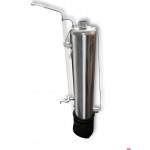
Household Autoclave Construction
Autoclaving is the most reliable method of sterilizing preserves. After processing in the unit at 120°C, preserves retain their taste and nutrients while neutralizing potential parasites.
For example - electric autoclave
In this article, we will thoroughly examine and schematically demonstrate all the components that make up a household autoclave. In our case, we present the electric variant. The gas version has exactly the same construction, excluding the electrical parts. So, let's get started!

Autoclave Construction for Home Canning
- Elliptical Bottom (bottom)
- Autoclave Body
- Handles
- Elliptical Bottom (top)
- Flange
- Sealing Rubber
- Safety Valve
- Alcohol Thermometer
- Tap + Nozzle
- Pressure Gauge
- Studs + Nuts
- Autoclave Lid
- Plug
- Control Unit
- Wiring
- Protective Cover
- Temperature Sensor
If any of the components of the household autoclave are unfamiliar or unclear to you, we suggest getting to know them in more detail
1. Elliptical Bottom (bottom). The bottoms are made from sheet metal using rotational drawing and are used as the bottom and top parts of both household and industrial autoclaves. Pressure vessels must be cylindrical in shape without sharp angles or flat surfaces. Only such shapes allow for easy maintenance of pressure without deformation.
2. Autoclave Body. Made from sheet metal with a thickness of 1.5 mm by rolling. It represents the main cylindrical part of the tank.
3. Handles. Made from stainless steel. Used for convenience in lifting and carrying the unit.
4. Elliptical Bottom (top). The bottom with an opening for the flange and lid.
5. Flange. A very important part of the autoclave responsible for its tightness. It is welded directly to the top bottom and has rims or grooves for pressing the sealing rubber. Additionally, the flange has holes for the studs.
6. Sealing Rubber. Special heat-resistant rubber with a thickness of 6 mm. Located between the lid and the flange. When the lid is pressed against the flange, the rubber fits into the upper and lower grooves, providing complete tightness.
7. Safety Valve. A rupture valve from AquaWorld rated at 6 atm. It acts as a safety measure. If the pressure in the autoclave rises above the permissible norm, it will trigger and release the excess. It is very important that the valve is not adjustable; it comes from the factory calibrated to 6 atm. This guarantees its reliability and protects against incorrect settings as with adjustable valves.
8. Alcohol Thermometer. Present to display the working temperature inside the tank. It is used only in autoclaves that are placed on an open flame. In the electric version, there is a special control unit that displays the current temperature.
9. Tap + Nozzle. This pair is intended to create an initial pressure of 1 atm in the autoclave. After which, the tap is closed and all the load is on it (it is heat-resistant and designed for high pressure).
10. Pressure Gauge. A device that shows the current pressure in the tank. The scale goes up to 6 atm.
11. Studs + Nuts. The studs are made of food-grade stainless steel. Nuts are made of ordinary metal. Why, you ask? This is very important for preserving the threads on the stud. If the user improperly tightens the nut or screws it in crookedly, they physically cannot strip the threads on the stud, as it is made from harder metal than the nut. The maximum that can suffer is the nut, which can be easily replaced.
12. Autoclave Lid. Made from stainless sheet metal with a thickness of 6-8 mm. The lid has openings for components and holes for the studs. Additionally, three grooves are cut on the back side for sealing.
13. Plug. A standard plug for an electrical socket.
14. Control Unit. Automatic temperature control and timer counting - this is what our complex thermostat is responsible for. Today, you set the desired operating parameters, and you can relax, as the device will bring the autoclave to the desired temperature, turn on the timer, and turn off the autoclave. Full automation.
15. Wiring. An electrical cord with a cross-section of 2.5 mm² with grounding. Easily handles the power of the heater.
16. Protective Cover. A stainless steel box designed to protect against direct access to the electrical parts of the autoclave.
17. Temperature Sensor. Serves to determine and display the working temperature inside the tank.
You can purchase a household autoclave on our website: up to 50 years warranty, high-quality stainless steel.
Also read:
- Autoclave Operating Modes
- What is an Autoclave
- Hydraulic Testing of Autoclaves
- How to Use an Autoclave
- How to Choose an Autoclave









